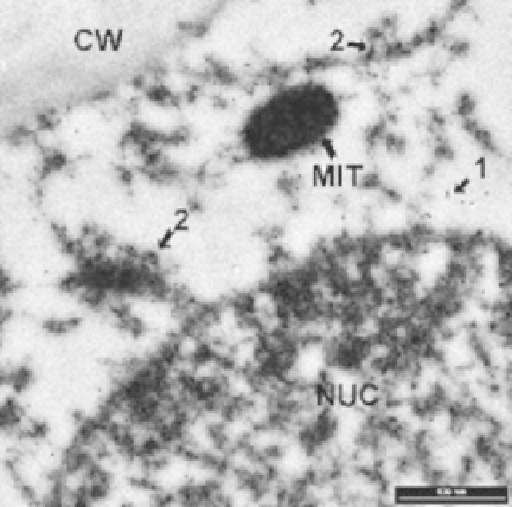Agriculture Reference
In-Depth Information
Fig. 9.9
Immunohistochemical localization of phospholipase D in tomato fruits. The sections were incubated
with polyclonal antibodies raised against rapeseed phospholipase D and localized with goat antirabbit 1 gG
coupled to 10-nm gold particles. The gold particles can be visualized in the cytosol (1), bound to the membrane
(2), attached to the nuclear membranes (Nuc), and mitochondria (Mit). CW, cell wall. (Reproduced with permission
from Pinhero et al., 2003.)
membranes (Todd et al., 1990, 1992; Pinhero et al., 2003). Since the activity of PLD appears
to be the key step regulating the sequence of enzyme reactions and the flow of metabolites
through the catabolic pathway (Fig. 9.4), this indirectly implies that controlling the activity
of PLD is critical for enhancing the shelf life and quality of fruits and vegetables. Therefore,
attempts have been made to clone
PLD
genes from fruits and vegetables and to understand
their regulation during ripening and senescence. PLD activity in membrane preparations of
germinating bean cotyledons, tomato fruit, strawberry fruit, and carnation flower petals was
stimulated at physiologically elevated micromolar levels of calcium, which suggested that
phospholipase D activation may be mediated through calcium signal transduction events.
This proposed mechanism is currently being studied.
Studies on the properties and regulation of phospholipase D date back several decades,
and the special enzymological property of transphosphatidylation was well recognized
(Galliard, 1980). Recent advances on the physiological and molecular aspects of PLD
have been summarized by Wang (1999, 2000, 2001, 2002, 2005). The functional signifi-
cance of different forms of plant PLDs, in relation to developmental processes and signal
transduction, appear to result from their differential ability to bind to the membrane, sub-
strate specificity, and activation by calcium, low pH, phosphatidylinositol-4,5-bisphosphate
(PIP
2
), and several other factors. Complimentary DNA encoding several PLDs have been
cloned, sequenced, expressed, and their physiological roles studied. These include PLDs
from plants such as
Arabidopsis
, rice, maize, cabbage, castor bean, tomato, strawberry,









Search WWH ::

Custom Search